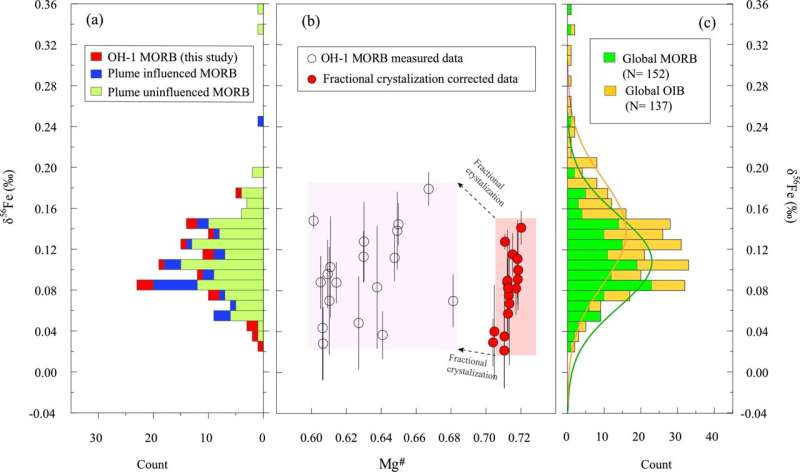(a) Histogram of δ56Fe of OH-1 MORB lavas, compared with the available global MORB data from ridges far from hotspots (Weyer and Ionov, 2007; Teng et al., 2013; Nebel et al., 2013; Chen et al., 2019; Sun et al., 2020; Richter et al., 2021) and ridges influenced by mantle plumes (Gleeson et al., 2020); (b) δ56Fe vs. Mg# diagram for OH-1 MORB lavas. (c) Histogram of so-far available global MORB δ56Fe data to show remarkable similarity to those of OIB in terms of Fe isotope variations range. The orange and green curves are normal distribution of global OIB and MORB, respectively. Credit: Earth and Planetary Science Letters (2022). DOI: 10.1016/j.epsl.2022.117892
Studies of mid-ocean ridge basalts (MORBs) show a variable Fe isotope composition of the oceanic upper mantle, beyond explanation by processes of mantle melting from a uniform source and magma evolution, indicating Fe isotope heterogeneity in the oceanic upper mantle. However, the origin of upper mantle Fe isotope heterogeneity remains enigmatic.
In order to verify the hypothesis that MORB mantle heavy Fe isotope (56, 57Fe vs. light 54Fe) enrichment results from the same process of incompatible element enrichment associated with low-degree melt mantle metasomatism in Earth's history, a research team led by Dr. Guo Pengyuan from the Institute of Oceanology of the Chinese Academy of Sciences (IOCAS) conducted an Fe isotope study of well-characterized MORB samples from a magmatically robust segment (OH-1) of the Mid-Atlantic Ridge (MAR) at ~ 35°N.
The study was published in Earth and Planetary Science Letters.
The studied 18 samples showed large δ56Fe variation, reflecting a rather large MORB Fe isotope variability on such a ridge segment scale. "What is striking is the statistically significant correlations of δ56Fecorr with the abundances and ratios of more-to-less incompatible elements, and even with Sr-Nd-Hf isotopes," said Dr. Guo.
The large δ56Fe variation and the significant correlations with abundances and ratios of incompatible elements and with radiogenic isotopes of the OH-1 lavas were not caused by seawater alteration, partial melting, magma evolution and mixing in the magma chamber; they reflected a clear mantle source inheritance beneath this part of the MAR.
Low-degree melting can effectively fractionate elements of varying incompatibilities, especially between elements with small or subtle incompatibility difference. Thus, the correlated Fe isotope variation (δ56Fe = +0.03 to +0.18 ‰) with the abundances and ratios of incompatible elements indicates a common process that leads to enrichment of heavy Fe and incompatible elements.
"We explain this process as low-F melt mantle metasomatism taking place at the oceanic lithosphere-asthenosphere boundary in earth's history," said Dr. Guo. Melting of such recycled composite lithologies beneath the present-day sub-ridge produces MORB melts with geochemical correlations as observed at ridge segment OH-1 of the MAR. The positive correlation of δ56Fe with 87Sr/86Sr and negative correlations with 143Nd/144Nd and 176Hf/177Hf further indicate an ancient formation of the low-F melt metasomatic mantle.
"We suggest that low-F melt mantle metasomatism causing upper mantle heavy Fe isotope enrichment is a globally common process and widespread, because the available global MORB Fe isotopes show systematic correlations with the abundances and ratios of their incompatible elements," said Dr. Guo.
More information: Pengyuan Guo et al, Low-degree melt metasomatic origin of heavy Fe isotope enrichment in the MORB mantle, Earth and Planetary Science Letters (2022). DOI: 10.1016/j.epsl.2022.117892
Journal information: Earth and Planetary Science Letters
Provided by Chinese Academy of Sciences
























